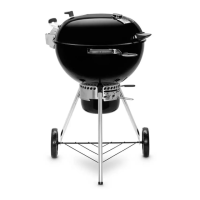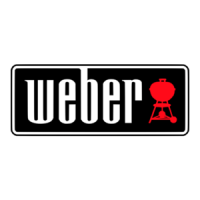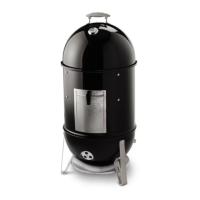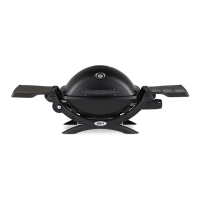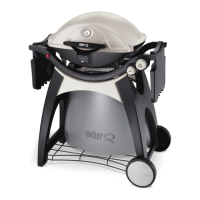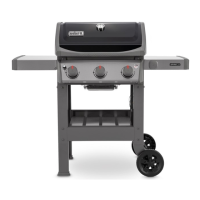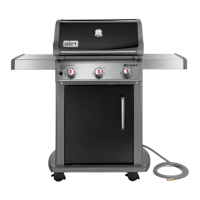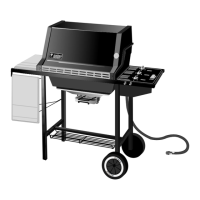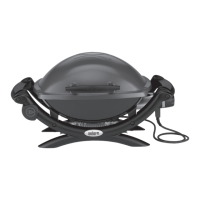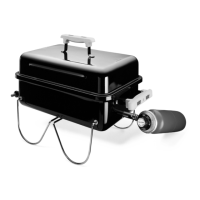6
Wear Gloves
Always wear a barbecue mitt or mitts when using your charcoal
grill. Vents, dampers, handles, and the bowl will all get hot during
the grilling process, so be sure to keep your hands and forearms
protected.
Skip the Lighter Fluid
Avoid using lighter fluid, as it can impart a chemical taste to your
food. Chimney starters (sold separately) and lighter cubes (sold
separately) are much cleaner and much more effective ways of
lighting charcoal.
Preheat the Grill
Preheating your grill with the lid closed for 10 to 15 minutes
prepares the cooking grate. With all of the charcoal glowing red,
the temperature under the lid should reach 500˚F. The heat loosens
any bits and pieces of food hanging onto the grate, making it easy to
brush them off with a stainless steel bristle grill brush. Preheating
your grill gets the grate hot enough to sear properly and also helps
prevent food from sticking to the grate.
Note: Use a stainless steel bristle grill brush. Replace brush if any
loose bristles are found on cooking grate or brush.
Oil the Food, Not the Grate
Oil prevents food from sticking and also adds flavor and moisture.
Lightly brushing or spraying the food with oil works better than
brushing the grate.
Keep the Air Flowing
A charcoal fire needs air. The lid should be closed as much as
possible, but keep the lid damper and bowl vent open. Remove the
ashes on the bottom of the grill regularly to prevent them from
blocking the vents.
Put a Lid on It
For four important reasons, the lid should be closed as much as
possible.
1. Keeps the grate hot enough to sear the food.
2. Speeds up the cooking time and prevents the food from drying
out.
3. Traps the smokiness that develops when fat and juices vaporize
in the grill.
4. Prevents flare-ups by limiting oxygen.
Tame the Flame
Flare-ups happen, which is good because they sear the surface of
what you are grilling; however, too many flare-ups can burn your
food. Keep the lid on as much as possible. This limits the amount
of oxygen inside the grill, which will help extinguish any flare-ups.
If the flames are getting out of control, move the food over indirect
heat temporarily, until they die down.
Frozen or Fresh
Whether you are grilling frozen or fresh food, follow the safety
guidelines on the package and always cook it to the recommended
internal temperature. Frozen food will take longer to grill and may
need more fuel to be added depending on the type of food.
Keeping it Clean
Follow a few basic maintenance instructions to keep your grill
looking and grilling better for years to come!
• For proper air flow and better grilling, remove accumulated
ashes and old charcoal from the bottom of the kettle and the ash
catcher before use. Make sure that all of the charcoal is fully
extinguished and the grill is cool before doingso.
• You may notice “paint-like” flakes on the inside of the lid. During
use, grease and smoke vapors slowly oxidize into carbon and
deposit on the inside of your lid. Brush the carbonized grease
from the inside of the lid with a stainless steel bristle grill brush.
To minimize further build-up, the inside of the lid can be wiped
with a paper towel after cooking while the grill is still warm (not
hot).
• Clean painted, porcelain-enameled, and plastic surfaces on
the outside of your grill with warm soapy water and a non-
abrasive cloth.
• If your grill is subject to a particularly harsh environment, you
will want to clean the outside more often. Acid rain, chemicals,
and salt water can cause surface rusting to appear. WEBER
recommends wiping down the outside of your grill with warm
soapy water. Follow up with a rinse and thorough drying.
• Do not use any of the following to clean your grill: abrasive
stainless steel polishes or paints, cleaners that contain acid,
mineral spirits or xylene, oven cleaner, abrasive cleansers
(kitchen cleansers), and abrasive cleaning pads.
TIPS AND TRICKS FOOD SAFETY
Food Safety Tips
• Do not defrost meat, fish, or poultry at room temperature. Defrost in the refrigerator.
• Wash your hands thoroughly with hot, soapy water before starting any meal preparation and after
handling fresh meat, fish, and poultry.
• Never place cooked food on the same plate raw food was on.
• Wash all plates and cooking utensils that have come into contact with raw meats or fish with hot,
soapy water and rinse.
Visit www.weber.com for recipes and barbecuing tips.
Cooking times for beef and lamb use the USDA’s definition of medium doneness, unless otherwise noted. The cuts, thicknesses, weights, and
grilling times are meant to be guidelines. Factors such as altitude, wind, and outside temperature can affect cooking times.
Visit www.weber.com for recipes and grilling tips.
Thickness / Weight Approximate Total Grilling Time
RED MEAT
Steak: New York strip,
porterhouse, rib-eye, T-bone,
and filet mignon (tenderloin)
¾ in (1.9 cm) thick 4 to 6 minutes direct high heat
1 in (2.5 cm) thick 6 to 8 minutes direct high heat
2 in (5 cm) thick
14 to 18 minutes
sear 6 to 8 minutes direct high heat,
and grill 8 to 10 minutes indirect high heat
Flank Steak
1½ lb to 2 lb (680 g to 907 g),
¾ in (1.9 cm) thick
8 to 10 minutes direct medium heat
Ground Beef Patty ¾ in (1.9 cm) thick 8 to 10 minutes direct medium heat
Tenderloin 3 lb to 4 lb (1.36 kg to 1.81 kg)
45 to 60 minutes 15 minutes direct medium heat,
and grill 30 to 45 minutes indirect medium heat
PORK
Bratwurst: fresh 3 oz (85 g) link 20 to 25 minutes direct low heat
Chop: boneless or bone in
¾ in (1.9 cm) thick 6 to 8 minutes direct high heat
1¼ in to 1½ in
(3.17 cm to 3.81 cm) thick
10 to 12 minutes sear 6 minutes direct high heat,
and grill 4 to 6 minutes indirect high heat
Ribs: baby back, spareribs 3 lb to 4 lb (1.36 kg to 1.81 kg) 1½ to 2 hours indirect medium heat
Ribs: country-style, bone in 3 lb to 4 lb (1.36 kg to 1.81 kg) 1½ to 2 hours indirect medium heat
Tenderloin 1 lb (453 g)
30 minutes sear 5 minutes direct high heat,
and grill 25 minutes indirect medium heat
POULTRY
Chicken Breast: boneless, skinless 6 oz to 8 oz (170 g to 226 g) 8 to 12 minutes direct medium heat
Chicken Thigh: boneless, skinless 4 oz (113 g) 8 to 10 minutes direct medium heat
Chicken Pieces: bone in, assorted 3 oz to 6 oz (85 g to 170 g)
36 to 40 minutes 6 to 10 minutes direct low heat,
30 minutes indirect medium heat
Chicken: whole 4 lb (1.81 kg) to 5 lb (2.26 kg) 1 to 1¼ hours indirect medium heat
Cornish Game Hen 1½ lb (680 g) to 2 lb (907 g) 60 to 70 minutes indirect medium heat
Turkey: whole, unstued 10 lb (4.53 kg) to 12 lb (5.44 kg) 2 to 2½ hours indirect medium heat
SEAFOOD
Fish, Fillet, or Steak:
halibut, red snapper, salmon,
sea bass, swordfish, tuna
¼ in to ½ in
(0.63 cm to 1.27 cm) thick
3 to 5 minutes direct medium heat
1 in to 1¼ in
(2.54 cm to 3.17 cm) thick
10 to 12 minutes direct medium heat
Fish: whole
1 lb (453 g) 15 to 20 minutes indirect medium heat
3 lb (1.36 kg) 30 to 45 minutes indirect medium heat
Shrimp 1½ oz (28 g) 2 to 4 minutes direct high heat
VEGETABLES
Asparagus ½ in (1.27 cm) diameter 6 to 8 minutes direct medium heat
Corn
in husk 25 to 30 minutes direct medium heat
husked 10 to 15 minutes direct medium heat
Mushroom
shiitake or button 8 to 10 minutes direct medium heat
portobello 10 to 15 minutes direct medium heat
Onion
halved 35 to 40 minutes indirect medium heat
½ in (1.27 cm) slices 8 to 12 minutes direct medium heat
Potato
whole 45 to 60 minutes indirect medium heat
½ in (1.27 cm) slices
9 to 11 minutes parboil 3 minutes,
and grill 6 to 8 minutes direct medium heat
Make sure food fits on the grill with the lid down, leaving approximately 1 inch (2.54 cm) of clearance between the food and lid.
GRILLING GUIDE
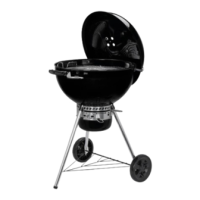
